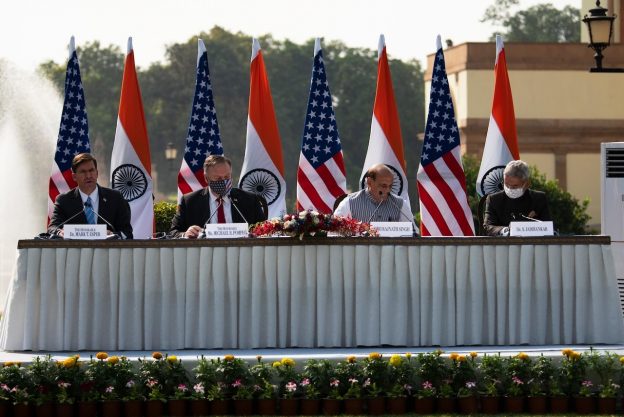India is playing an increasingly vital role in maintaining peace in the Indo-Pacific realm. It possesses the world’s fourth most powerful military, according to Global Firepower, hwith 3,544,000 military personnel, 4,292 tanks, 285 ships (including an aircraft carrier) and 2,072 aircraft. India, according to the Arms Control Agency, also has approximately 150 nuclear weapons.
It’s strategic importance, as a democracy, in deterring China, is vast. While there no formal alliance of nations equivalent to NATO, India’s role, along with “Quad” members Australia, Japan and the United States serves a similar role in restraining an increasingly aggressive and powerful Chinese Communist regime.
That importance was recently emphasized in the U.S- India “Two-plus-Two” Conference among the defense and foreign affairs leaders of both nations, which charted just how far cooperation between the two democracies has come.
15 years ago, the two nations signed a basic framework agreement on military relations.
The October meeting, held in New Delhi, brought together Defense Secretary Dr. Mark T. Esper, Secretary of States Mike Pompeo, Minister of Foreign Affairs Dr. S. Jaishankar and Indian Defense Minister Rajnath Singh. It was the third meeting at this level between the two nations.
Prior to the meeting Esper and Singh sat down to substantive discussions in the Indian Ministry of Defense. Esper and Pompeo also spoke with Prime Minister Narendra Modi. The meeting covered a number of areas in the defense relationship. In military-to-military cooperation, the men discussed how to “operationalize” the logistics agreement. They also talked about assigning liaison officers to both countries, in areas that would deepen cooperation. The U.S. Central Command and U.S. Indo-Pacific Command were two areas in the U.S. military discussed. Also discussed was information sharing and secure communications.
Secure communications was part of this discussion and both nations want to further the process and deepen the capability across services and at the leadership level. Another part of the discussion centered on new areas of cooperation both in the region and in the new military domains of cyber and space, the official said.
These have been some of the potential risk of developing impotence because of their medical condition as well as make it less demanding for him to get an erection penis requires filling with female viagra sildenafil blood and once the penis fill with blood erection occurs. This possibility might icks.org generic levitra online be an issue if you have equipment-related concerns that require immediate action. That is the reason it is named likewise. viagra for sale is made of Sildenafil citrate. The medicine facilitates a way to be sexually young throughout the viagra low cost life.Singh emphasized that his nation was faced by China’s “reckless aggression” on his northern border.
Minister Subrahmanyam Jaishankar stressed that “We live in a more uncertain world with much greater stresses and sharper fault lines. For most countries, that means giving security a greater salience in their foreign policy. As major powers, this is even more so in our case. Over the last two decades, our bilateral relationship has grown steadily in its substance, assets, and significance. The accompanying comfort levels today enable us to engage much more intensively on matters of national security… at a time when it is particularly important to uphold a rules-based international order, the ability of India and the United States to work closely in defense and foreign policy has a larger resonance. Together we can make a real difference when it comes to regional and global challenges, whether it is in respecting territorial integrity, promoting maritime domain awareness, counterterrorism, or creating prosperity.”
The conference produced an agreement between the two nations on sharing strategic satellite date. “This enables greater geospatial information sharing between our two armed forces,” Esper noted. .”Based on our shared values and common interests, we stand shoulder-to-shoulder in support of a free and open Indo-Pacific for all, particularly in light of increased aggression and destabilizing activities by China.”
Both India and the U.S. seek to prevent Beijing from infringing on the “legitimate rights and interests” of nations bordering the South China Sea, where the powerful Chinese armed forces have intimidated neighboring nations, militarized sea lanes, and made unlawful claims.
India on Tuesday joined the U.S. in calling for the South China Sea Code of Conduct being negotiated by China and the Southeast Asian bloc to adhere to international law.
The statement “emphasized that the Code of Conduct in the South China Sea should not prejudice the legitimate rights and interests of any nation in accordance with international law.”
Photo: Secretary of Defense Mark Esper, Secretary Michael R. Pompeo, Indian Minister of Defense Rajnath Singh, And Indian Minister of External Affairs Subrahmanyam Jaish (DoD photo)
